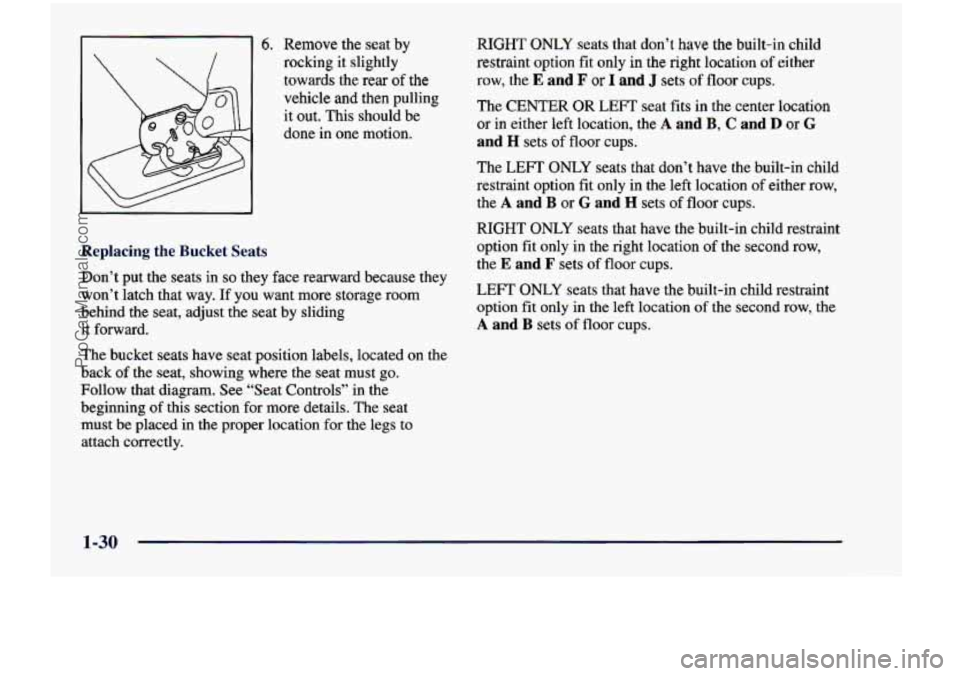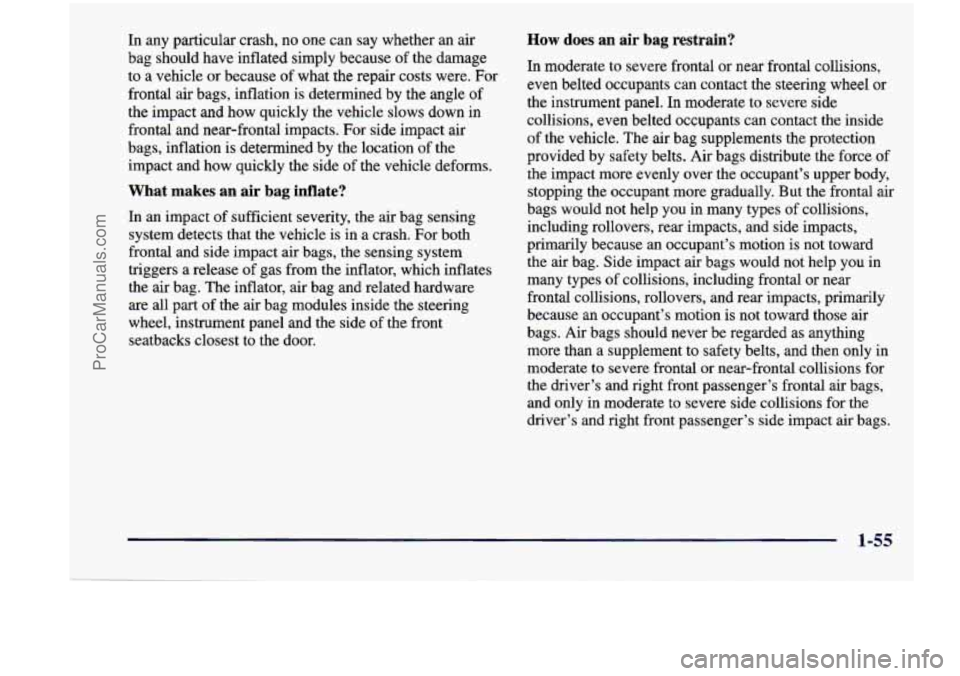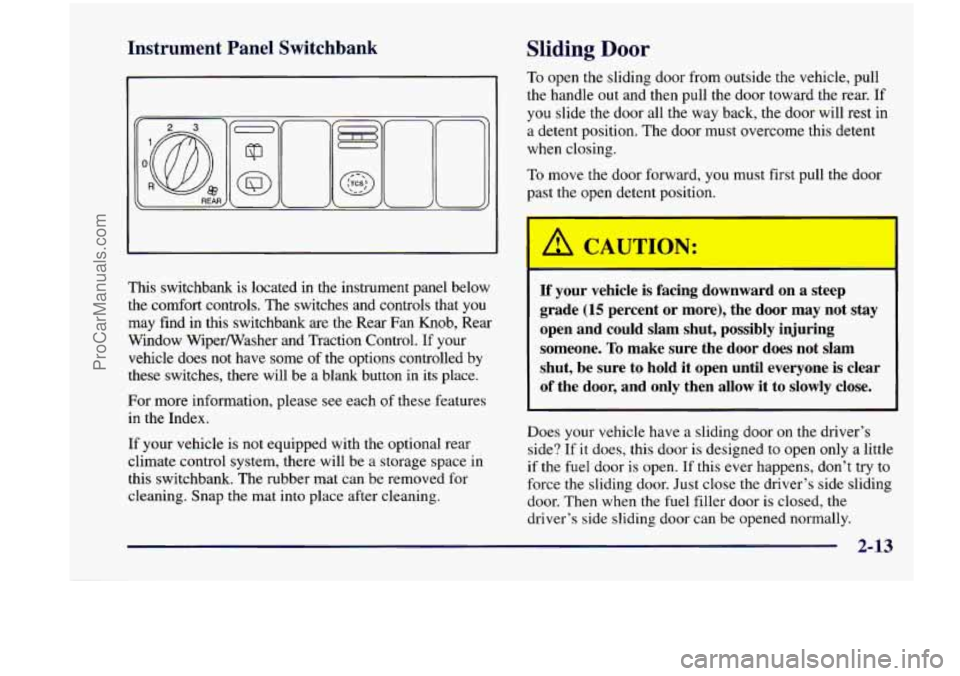Page 43 of 474

6. Remove the seat by
rocking it slightly
towards the rear
of the
vehicle and then pulling
it out. This should be
done
in one motion.
Replacing the Bucket Seats
Don’t put the seats in so they face rearward because they
won’t latch that way.
If you want more storage room
behind the seat, adjust the seat by sliding
it forward.
The bucket seats have seat position labels, located on the
back
of the seat, showing where the seat must go.
Follow that diagram. See “Seat Controls” in the
beginning
of this section for more details. The seat
must be placed in the proper location for
the legs to
attach correctly. RIGHT
ONLY seats that don’t have the built-in child
restraint option
fit only in the right location of either
row, the
E and F or I and J sets of floor cups.
The
CENTER OR LEFT seat fits in the center location
or in either left location, the A and B, C and D or G
and H sets of floor cups.
The
LEFT ONLY seats that don’t have the built-in child
restraint option fit only in the left location
of either row,
the
A and B or G and H sets of floor cups.
RIGHT ONLY seats that have the built-in child restraint
option
fit only in the right location of the second row,
the
E and F sets of floor cups.
LEFT ONLY seats that have the built-in child restraint
option fit only in the left location
of the second row, the
A and B sets of floor cups.
1-30
ProCarManuals.com
Page 44 of 474
Make sure the seat is in the full rear position before
beginning this procedure.
1. With the seat folded, squeeze the angled gray bar
towards the solid gray crossbar while placing the front
hooks of the bench seat onto the front two floor pins.
To do this, the seat will
need to be angled
so
that the front hooks
clear the floor pins.
2. If the front legs are not attached correctly, the rear
legs will not attach to the rear set of floor pins.
1-31
ProCarManuals.com
Page 68 of 474

In any particular crash, no one can say whether an air How does an air bag restrain?
bag should have inflated simply because of the damage
In moderate to severe frontal or near frontal collisions,
to a vehicle or because of what the repair costs were. For even belted occupants can contact the steering wheel or
frontal air bags, inflation is determined by the angle of
the impact and how quickly the vehicle slows down in the instrument panel. In moderate to severe side
collisions, even belted occupants can contact the inside
frontal and near-frontal impacts. For side impact air
of the vehicle. The air bag supplements the protection
bags, inflation is determined by the location of the
provided by safety belts. Air bags distribute the force
of
and how quickly the side Of the deforms* the impact more evenly over the occupant’s upper body,
What makes an air bag inflate?
In an impact of sufficient severity, the air bag sensing
system detects that the vehicle is in a crash. For both
frontal and side impact air bags, the sensing system
triggers a release
of gas from the inflator, which inflates
the air bag. The inflator, air bag and related hardware
are all part
of the air bag modules inside the steering
wheel, instrument panel and the side
of the front
seatbacks closest to the door. stopping
the occupant more gradually But the frontal air
bags would not help you in many types of collisions,
including rollovers, rear impacts, and side impacts,
primarily because an occupant’s motion is not toward
the air bag. Side impact air bags would not help you in
many types of collisions, including frontal or near
frontal collisions, rollovers, and rear impacts, primarily
because an occupant’s motion is not toward those air
bags. Air bags should never be regarded as anything
more than a supplement to safety belts, and then only in
moderate to severe frontal or near-frontal collisions for
the driver’s and right front passenger’s frontal air bags,
and only in moderate
to severe side collisions for the
driver’s and right front passenger’s side impact air bags.
1-55
ProCarManuals.com
Page 70 of 474

NOTICE:
If you damage the covering for the driver’s or the
right front passenger’s air bag, or the air bag
covering on the driver’s and right front
passenger’s seatback, the bag may not work
properly. You may have to replace the air bag
module in the steering wheel, both the air bag
module and the instrument panel for the right
front passenger’s air bag, or both the air bag
module and seatback for the driver’s and right
front passenger’s side impact air bag.
Do not
open or break the air bag coverings.
If your vehicle ever gets into a lot of water -- such as
water up to the carpeting or higher
-- or if water enters
your vehicle and soaks the carpet, the air bag controller
can
be soaked and ruined. If this ever happens, and then
you
start your vehicle, the damage could make the
frontal and side impact air bags inflate and safety belt
pretensioners activate, even if there’s no crash.
You
would have to replace the air bags, all the sensors and
related parts, parts of the safety belt system and parts
of
the driver and right front passenger’s seatbacks. If your
vehicle is ever
in a flood, or if it’s exposed to water that
soaks the carpet, you can avoid needless repair costs by
turning
off the vehicle immediately. Don’t let anyone
start the vehicle, even to tow it, unless the battery cables
are first disconnected.
ProCarManuals.com
Page 96 of 474
An infant car bed (A) is a special bed made for use
in
a motor vehicle. It’s an infant restraint system
designed
to restrain or position a child on a
continuous flat surface. With an infant car bed,
make sure that the infant’s head rests toward the
center of the vehicle.
A rear-facing infant restraint (B) positions an infant
to face the rear
of the vehicle. Rear-facing infant
restraints are designed for infants of up to about
20 lbs. (9 kg) and about one year of age. This type
of restraint faces the rear so that the infant’s head,
neck and body can have the support they need in a
crash. Some infant seats come in two parts
-- the
base stays secured in the vehicle and the seat part
is removable.
1-83
ProCarManuals.com
Page 112 of 474
.
Never do this.
Here two children are wearing the same belt. The
belt can’t properly spread the impact forces.
In a
crash, the two children can be crushed together
and seriously injured.
A belt must be used by
only one person at a time.
What
if a child is wearing a lap-shoulder belt,
but the child is
so small that the shoulder belt is
very close to the child’s face or neck?
A: Move the child toward the center of the vehicle, but
be sure that the shoulder belt still is
on the child’s
shoulder,
so that in a crash the child’s upper body
would have the restraint that belts provide.
If the
child is sitting in a rear seat outside position, see
“Rear Safety Belt
Comfort Guides” in the Index.
If the child is so small that the shoulder belt is still
very close to the child’s face or neck,
you might
want to place the child in a seat that has a lap belt,
if
your vehicle has one.
1-99
ProCarManuals.com
Page 121 of 474
Door Locks
I A CAUTION:
Unlocked doors can be dangerous.
Passengers
-- especially children -- can easily
open the doors and fall out. When
a door is
locked, the inside handle won’t open it.
Outsiders can easily enter through an unlocked
door when you slow down or stop your vehicle.
This may not be
so obvious: You increase the
chance of being thrown out
of the vehicle in a
crash if the doors aren’t locked. Wear safety belts
properly, lock your doors, and you will be far
better
off whenever you drive your vehicle. There are several ways
to lock and unlock your vehicle.
From the outside,
use your key or the remote keyless
entry transmitter (if your vehicle has this option).
To unlock either front door from the outside with
the key, insert the key and turn
it toward the front of
the vehicle.
You can lock either front door from the outside with
your key by inserting and turning
it toward the rear of
the vehicle.
2-4
ProCarManuals.com
Page 130 of 474

Instrument Panel Switchbank Sliding Door
IF, L
This switchbank is located in the instrument panel below the comfort controls. The switches and controls that you
may find
in this switchbank are the Rear Fan Knob, Rear
Window WiperNasher and Traction Control.
If your
vehicle does not have some
of the options controlled by
these switches, there will be a blank button in its place.
For more information, please
see each of these features
in the Index.
If your vehicle is not equipped with the optional rear
climate control system, there will be
a storage space in
this switchbank. The rubber mat can be removed for
cleaning. Snap the mat into place after cleaning.
To open the sliding door from outside the vehicle, pull
the handle out and then pull the door toward the rear.
If
you slide the door all the way back, the door will rest in
a detent position. The door must overcome this detent
when closing.
To move the door forward, you must first pull the door
past the open detent position.
I I CAUTION:
If your vehicle is facing downward on a steep
grade
(15 percent or more), the door may not stay
open and could slam shut, possibly injuring someone.
To make sure the door does not slam
shut, be sure to hold it open until everyone is clear
of the door, and only then allow it to slowly close.
Does your vehicle have a sliding door on the driver’s
side?
If it does, this door is designed to open only a little
if the fuel door
is open. If this ever happens, don’t try to
force the sliding door, Just close the driver’s side sliding
door. Then when the
fuel filler door is closed, the
driver’s side sliding door can be opened normally.
2-13
ProCarManuals.com